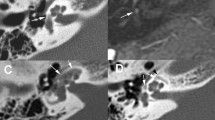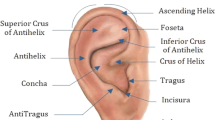Abstract
The aim of this study was to assess the hearing results after unilateral stapes surgery for otosclerosis at Cluj-Napoca University Hospital, and to evaluate surgical trauma to the inner ear in these patients. The medical records of 387 consecutive patients who underwent unilateral stapes surgery were reviewed. Hearing results were evaluated according to the 1995 American Academy of Otolaryngology-Head and Neck Surgery Committee on Hearing and Equilibrium guidelines and the Glasgow benefit plot. In addition we used Amsterdam plot to give an overview on air conduction gain and bone-conduction differences on an individual level. Results were analyzed separately for patients with preoperative unilateral, bilateral asymmetrical, and bilateral symmetrical hearing loss. Despite good technical hearing results after surgery (closure of the air-bone gap to ≤20 dB in 92 % of patients, air conduction gain of 24 ± 10.00 dB), only 37 % of patients achieved functionally normal, symmetrical hearing. Our results indicated that the pattern of preoperative hearing impairment in patients with otosclerosis can predict postoperative functional hearing results. The type of preoperative hearing impairment had.





Similar content being viewed by others
References
Shea JJ Jr (1998) Forty years of stapes surgery. Am J Otol 19(1):52–55
Bulman CH (2000) Audit of stapedectomy in the north west of England for 1996 and an analysis of the criteria used to describe success. Clin Otolaryngol 25:542–546. doi:10.1046/j.1365-2273.2000.00419.x
Schmerber S, Karkas A, Righini CA, Chahine KA (2008) The quartile benefit plot: a middle ear surgery benefit assessment scheme. Laryngoscope 118(5):843–848. doi:10.1097/MLG.0b013e318163cd28
Monsell EM, Balkany TA, Gates GA, Goldenberg RA, Meyerhoff WL, House JW (1995) Committee on hearing and equilibrium guidelines for the evaluation of results of treatment of conductive hearing loss. Otolaryngol Head Neck Surg 113(3):186–187. doi:10.1016/S0194-5998(95)70103-6
Lester PM (2005) Visual communication: images with messages. In: How we see. Wadsworth Publishing Company, Belmont, pp 3–28
Browning GG, Gatehouse S, Swan IR (1991) The Glasgow Benefit Plot: a new method for reporting benefits from middle ear surgery. Laryngoscope 101(2):180–185. doi:10.1288/00005537-199102000-00014
Kisilevsky V, Bailie NA, Halik JJ (2010) Bilateral hearing results of 751 unilateral stapedotomies evaluated with the Glasgow benefit plot. J Laryngol Otol 124(5):482–489. doi:10.1017/S0022215110000204
de Bruijn AJ, Tange RA, Dreschler WA (2001) Efficacy of evaluation of audiometric results after stapes surgery in otosclerosis. II. A method for reporting results from individual cases. Otolaryngol Head Neck Surg 124(1):84–89. doi:10.1067/mhn.111600
Smyth GDL, Hassard TH, El Kordy AF (1980) Long-term hearing performance after stapedectomy. J Laryngol Otol 94:1097–1105. doi:10.1017/S002221510008991X
Jantschi L, Bolboaca SD (2010) Exact probabilities and confidence limits for binomial samples: applied to the difference between two proportions. Sci World J 10:865–878. doi:10.1100/tsw.2010.75
Porter MJ, Zeitoun H, Brookes GB (1995) The Glasgow benefit plot used to assess the effect of bilateral stapedectomy. Clin Otol Laryngol Allied Sci 20(1):68–71. doi:10.1111/j.1365-2273.1995.tb00015.x
Aarnisalo AA, Vasama J-P, Hopsu E, Ramsay H (2003) Long-term hearing results after stapes surgery. A 20-year follow-up. Otol Neurotol 24(4):567–571
Perez-Lazaro JJ, Urquiza R, Cabrera A, Guerrero C, Navarro E (2005) Effectiveness assessment of otosclerosis surgery. Acta Oto Laryngol 125(9):935–945. doi:10.1080/00016480510038202
Bittermann AJ, Rovers MM, Tange RA, Vincent R, Dreschler WA, Grolman W (2011) Primary stapes surgery in patients with otosclerosis: prediction of postoperative outcome. Arch Otolaryngol Head Neck Surg 137(8):780–784. doi:10.1001/archoto.100
Van Rompaey V, Yung M, Claes J, Häusler R, Martin C, Somers T, Offeciers E, Pytel J, Skladzien J, Van de Heyning P (2009) Prospective effectiveness of stapes surgery for otosclerosis in a multicenter audit setting: feasibility of the Common Otology Database as a benchmark database. Otol Neurotol 30(8):1101–1110
Berliner KI, Doyle KJ, Goldenberg RA (1996) Reporting operative hearing results in stapes surgery: does choice of outcome measure make a difference? Am J Otol 17:521–528. doi:10.1097/MAO.0b013e3181b4eebf
de Bruijn AJ, Tange RA, Dreschler WA (2001) Efficacy of evaluation of audiometric results after stapes surgery in otosclerosis. I. The effects of using different audiologic parameters and criteria on success rates. Otolaryngol Head Neck Surg 124(1):76–83
Vincent R, Sperling NM, Oates J, Jindal M (2006) Surgical findings and long-term hearing results in 3,050 stapedotomies for primary otosclerosis: a prospective study with the otology-neurotology database. Otol Neurotol 27(8):S25–S47. doi:10.1097/01.mao.0000235311.80066.df
Lundman L, Mendel L, Bagger-Sjoback D, Rosenhall U (1999) Hearing in patients operated unilaterally for otosclerosis. Self assessment of hearing and audiometric results. Acta Otolaryngol 119(4):453–458. doi:10.1080/00016489950180982
Huang SC, Stanley RE (1995) Stapedectomy at the Singapore General Hospital-use of functional hearing analysis. Singap Med J 36(2):158–162
Caces F, Braccini F (2007) Comparative study using AAO-HNS guidelines for conductive hearing loss and Glasgow Benefit Plot to evaluate results of stapes surgery for otosclerosis: results of 129 cases. Rev Laryngol Otol Rhinol 128(1–2):47–53
Szymański M, Siwiec H, Gołabek W (2003) Glasgow Benefit Plot for evaluation of stapedectomy result. Otolaryngol Pol 57(3):403–406
Van Rompaey V, Claes G, Potvin J, Wouters K, Van de Heyning PH (2011) Systematic review of the literature on nitinol prostheses in surgery for otosclerosis: assessment of the adequacy of statistical power. Otol Neurotol 32(3):357–366. doi:10.1097/MAO.0b013e31820e7874
Faul F, Erdfelder E, Lang A-G, Buchner A (2007) G*Power 3: a flexible statistical power analysis for the social, behavioral, and biomedical sciences. Behav Res Methods 39(2):175–191. doi:10.3758/BF03193146]
Acknowledgments
None.
Conflict of interest
None.
Author information
Authors and Affiliations
Corresponding author
Rights and permissions
About this article
Cite this article
Maniu, A., Cosgarea, M. Technical and functional hearing results after unilateral stapes surgery for otosclerosis at Cluj-Napoca University Hospital. Eur Arch Otorhinolaryngol 270, 2215–2224 (2013). https://doi.org/10.1007/s00405-012-2261-7
Received:
Accepted:
Published:
Issue Date:
DOI: https://doi.org/10.1007/s00405-012-2261-7




